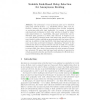Free Online Productivity Tools
i2Speak
i2Symbol
i2OCR
iTex2Img
iWeb2Print
iWeb2Shot
i2Type
iPdf2Split
iPdf2Merge
i2Bopomofo
i2Arabic
i2Style
i2Image
i2PDF
iLatex2Rtf
Sci2ools
PET
2009
Springer
2009
Springer
Scalable Link-Based Relay Selection for Anonymous Routing
The performance of an anonymous path can be described using many network metrics – e.g., bandwidth, latency, jitter, loss, etc. However, existing relay selection algorithms have focused exclusively on producing paths with high bandwidth. In contrast to traditional node-based path techniques in which relay selection is biased by relays’ node-characteristics (i.e., bandwidth), this paper presents the case for link-based path generation in which relay selection is weighted in favor of the highest performing links. Link-based relay selection supports more flexible routing, enabling anonymous paths with low latency, jitter, and loss, in addition to high bandwidth. Link-based approaches are also more secure than node-based techniques, eliminating “hotspots” in the network that attract a disproportionate amount of traffic. For example, misbehaving relays cannot advertise themselves as “low-latency” nodes to attract traffic, since latency has meaning only when measured between two...
| Added | 27 May 2010 |
| Updated | 27 May 2010 |
| Type | Conference |
| Year | 2009 |
| Where | PET |
| Authors | Micah Sherr, Matt Blaze, Boon Thau Loo |
Comments (0)

